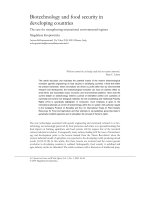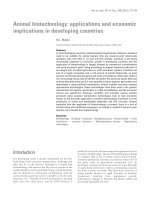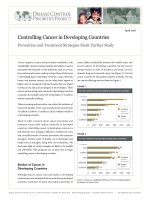Radiation therapy and cancer control in developing countries: Can we save more lives
Bạn đang xem bản rút gọn của tài liệu. Xem và tải ngay bản đầy đủ của tài liệu tại đây (413.14 KB, 5 trang )
13
Int. J. Med. Sci. 2017, Vol. 14
Ivyspring
International Publisher
International Journal of Medical Sciences
2017; 14(1): 13-17. doi: 10.7150/ijms.17288
Review
Radiation therapy and cancer control in developing
countries: Can we save more lives?
Rajamanickam Baskar1 and Koji Itahana2
1.
2.
Sengkang General and Community Hospital, Singapore;
Cancer and Stem Cell Biology Program, Duke-NUS Medical School, Singapore.
Corresponding author: Rajamanickam Baskar, M.Phil., Ph.D., Research Office, Sengkang General and Community Hospital, Sengkang Health at Alexandra
Hospital, 378 Alexandra Road, Singapore 159964. Email:
© Ivyspring International Publisher. This is an open access article distributed under the terms of the Creative Commons Attribution (CC BY-NC) license
( See for full terms and conditions.
Received: 2016.08.21; Accepted: 2016.11.01; Published: 2017.01.01
Abstract
Globally, morbidity and mortality due to cancer are predicted to increase in both men and women
in the coming decades. Furthermore, it is estimated that two thirds of these cancer-related deaths
will occur in low-and middle-income countries (LMIC). In addition to morbidity and mortality,
cancer also causes an enormous economic burden, especially in developing countries. There are
several treatment and management options for cancer including chemotherapy, radiation therapy,
surgery, and palliative care. Radiotherapy or radiation therapy (RT) can be an effective treatment,
especially for localized or solid cancers; about half of cancer patients receive radiation as a curative
or palliative treatment. Because of its low cost, for patients from LMIC with inoperable tumors, RT
may be the only option. With the overall increase in the number of cancer patients especially in
resource-starved LMIC, the need for more RT facilities further affects the economic growth of
those countries. Therefore, an advanced molecular-targeted and more integrated approach
involving either RT alone or with surgery and improved cancer drug access worldwide are urgent
needs for cancer care.
Key words: Developing countries, Cancer, Economic burden, Cell death, Radiation therapy.
The Burden of Cancer
Recent estimates from the World Health
Organization predict that the global incidence of
cancer will increase by ~65% from 14 million in 2012
to more than 22 million by 2030 [1], becoming a major
public health problem in all regions of the world.
Differences in cancer incidence and mortality rates
have been noted in different regions of the world,
with the highest rates occurring in low-and
middle-income countries (LMIC). Each year, 5 million
people die from cancer (10 percent of the 50 million
deaths) in LMIC, which is second only to deaths from
infectious diseases [2].
Based on human development index (HDI),
worldwide total incidence and mortality due to cancer
in 2012 is given in Table 1 [3]. HDI is measured based
on income level, education and life expectancy which
indicates the socio-economic status of the country [4].
Because cancer incidence increases with age, Bray and
Møller predicted that the elderly will comprise 60% of
cancer cases worldwide by 2050 and ~67% of those
cases will occur in LMIC [5]. As the incidence of
cancer increases concomitant with the aging of the
world’s population, the costs of diagnosis and
treatment will become a burden to the world
economy.
Table 1. Worldwide total incidence and mortality from cancer in
2012 based on the Human Development Index (HDI) [3].
High Development Index
Medium Development Index
Low Development Index
Overall
New cases (Millions)
7.9
5.2
0.94
14.1
Mortality (Millions)
3.9
3.7
0.69
8.2
14
Int. J. Med. Sci. 2017, Vol. 14
Cancer and Radiotherapy
The various treatment modalities for cancer
include chemotherapy, radiotherapy, immunetherapy, hormone therapy, surgery and palliative care
[6-8]. Radiation therapy or radiotherapy (RT) is
currently one of the most widely used treatment
options for cancer around the world because of its low
cost; approximately 50% of patients undergo radiation
treatment during the course of their disease (6, 9).
While RT is the cheapest treatment modality overall,
comprising only about 5% of the total cost of patient
care, limited sources are available in LMIC [10].
Although RT is a complex treatment, it can be
effectively standardized and delivered to the majority
of patients irrespective of their political/regional,
socioeconomic, and cultural context [11-13]. Studies
conducted in Australia, supported by the results of
studies in Canada and Sweden, reported that for
every 1000 newly diagnosed cancer cases, 523 patients
(52%) required RT, and about 120 patients (23%)
needed repeated radiation exposure to obtain a cure
[7, 14]. However, an International Atomic Energy
Agency (IAEA 2010) report suggested that in
developing countries at least 60% of cancer patients
require radiation treatment. Although 85% of world’s
population lives in LMIC, there are only 4,400
megavoltage radiation facilities available, which is far
less than 35% of the world’s RT facilities available in
the other regions of the world [15]. Since that report,
the number of available facilities in LMIC might have
increased by a few hundred, but that has been
without much impact.
Radiation therapy is used as a primary
treatment for many cancers, also given as
neo-adjuvant or adjuvant (before or after) with other
types of treatments such as chemotherapy and
surgery. Delaney et al [14] reported an ideal rate of RT
utilization in Australian cancer patients based on the
systematic search of published guidelines and
literature. RT utilization rate is defined as the rate of
cancer patients who will receive at least one course of
radiation treatment during their lifetime. Based on the
calculation, it has been indicated that 52% of cancer
patients have to be treated by RT. Furthermore,
cancers that show more than 50% of the ideal rate of
RT utilization are breast, lung, prostate, urinary
bladder, esophagus, stomach, pancreas, rectum, oral
cavity,
larynx,
oropharynx,
salivary
gland,
hypopharynx, paranasal sinuses, nasopharynx,
unknown primary (head and neck), cervix, central
nervous system and lymphoma. Comparison of these
estimations with actual RT delivery rate suggest that
some cancer types should be treated more by RT.
Globally cancers are treated by radiation alone or with
combination with other modalities effectively, but
some cancers are not, because of few cancer cells that
develop radiation resistant and cause a relapse.
Furthermore, recently Ahmed et al [16] reported an
intra-organ variation of the metastases treated by
radiation based on the formation and location of the
primary tumor. Therefore, attempts to combine
radiotherapy with cellular and molecular targeted
biological modalities which determine the sensitivity
or resistance to ionizing radiation is an urgent unmet
need.
The purpose of this article is to explain how RT
affects cancer cells to enable general practitioners,
non-specialist clinicians, and other healthcare workers
to advise cancer patients who come to them with
questions about how RT can be a treatment strategy to
cure cancer.
Types of radiation therapy
Soon after Roentgen discovered X-rays in 1985,
radiation was used as a treatment for cancer [17], and
eventually was identified as an effective treatment for
tumors located in critical organs [18, 19]. Cancer
patients receive radiation treatment in the form of
radionuclide implants (internal treatment) or as linear
energy transfer (LET) radiation (external treatment)
depending on the radiation source used.
In radiation biology, particles emitted when
atoms decay are defined as low or high LET radiation.
LET is a term used in dosimetry, which is defined as
the energy released by radiation over a defined
distance (expressed in keV/ μm). At the same level of
observed dose, high LET radiation was shown to be
more effective than low LET radiation for cancer
treatment. For RT, radiation is delivered primarily as
high energy sources like photons (gamma and
X-rays), charged particles (electrons), and protons.
The physical energy that is transferred to cancer cells
alters their sensitivity, survival, and metabolism, and
disrupts the tumor microenvironment (TME) [6, 20].
In external RT, high-energy rays (photons,
protons or particle radiation) are delivered via a
radiation beam from outside the body to the tumor.
This is the most common approach, which offers a
noninvasive alternative to surgery for vital organ
preservation. To achieve cure, RT is delivered in
multiple fractions based on the radiobiological nature
of cancer and various normal tissues present in the
path of radiation surrounding the cancer tissue. A
typical RT fraction consists of daily (5days/week)
exposure to 1.5 to 2 Gray (Gy) given over 5-7 weeks.
In comparison to normal cells, most cancer cells
proliferate rapidly; therefore, normal cells have time
to repair the radiation damage before replication [6].
Over the past 2-3 decades, RT technology has
15
Int. J. Med. Sci. 2017, Vol. 14
advanced to deliver the radiation at a higher dose
more accurately targeting the tumor and sparing the
surrounding normal tissues. Multiple technological
improvements in engineering and computing have
advanced radiation delivery capabilities such as
intensity-modulated
radiotherapy
(IMRT),
image-guided radiotherapy (IGRT), stereotactic
radiotherapy (SRT), and 3D-conformal radiotherapy
(3D-CRT). Proton beam therapy (PBT) is a more
recently developed technology that uses protons
rather than photons (used in traditional external beam
RT) to deliver the radiation dose. Although proton
therapy minimizes the total radiation dose and side
effects to the surrounding healthy normal tissues,
there is limited clinical evidence that directly
compares PBT with other types of photon-based RT
approaches.
Mechanisms of radiation-induced cell
death
Cancer cells are resistant to anti-growth signals
that prevent abnormal cell division. The main target
of radiation in cells is the genome, i.e., DNA.
Radiation acts as a physical agent that damages DNA
directly or produces free radicals (charged particles)
that damage the cellular DNA [21, 22]. Depending on
the observed dose in the cell, DNA damage occurs as
single-strand and double-strand DNA breaks, DNA
base changes, and DNA-protein cross links [23, 24].
In addition, ionizing radiation damages cells by
altering protein expression that affects signaling
pathways [20, 25, 26] involved in damage repair
mechanisms (Figure 1). Cellular DNA damage
activates the expression of ATM (ataxia–telangiectasia
mutated) and ATR (ataxia–telangiectasia and Rad3
related) kinases that are involved in the DNA damage
response, which in turn induces cell cycle arrest and
activates various downstream targets involved in
DNA repair [27, 28, 29]. The ability or inability of
repair mechanisms to fix damaged cellular DNA
decides the fate of the cell: survival or death.
Types of cell death
RT damages cells by various mechanisms as
discussed above; however, the cell death response to
irradiation is complex, and depending on the extent of
damage, cells die at various intervals and by various
mechanisms [30]. The Nomenclature Committee on
Cell Death (NCCD) identified thirteen types of cell
death [31]. RT mainly kills cell through the process of
apoptosis; cells also die via activation of
non-apoptotic signaling pathways such as mitotic
catastrophe (MC) pathway, necrosis, autophagy, and
immunogenic cell death (ICD) (Figure 1). RT also
induces permanent cell cycle arrest called cellular
senescence which is an intrinsic tumor suppressive
mechanism triggered by severe or irreparable DNA
damage (Figure 1).
Figure 1. Irradiation damages the genome (DNA) of the cancer cells producing single strand breaks (SSB) or double strand breaks (DSB), which are repaired by
several kinds of repair proteins. If cancer cells receive severe irreparable DNA damage, the cells undergo either cellular senescence or several types of cell death,
dependent on the cell context.
16
Int. J. Med. Sci. 2017, Vol. 14
Apoptosis is a form of programmed cell death
that represents a crucial mechanism to avoid
accumulation of cells with DNA damage and
mutations, and is a major cell death mechanism
involved in RT-related cell death. In MC, cancer cells
die with premature or inappropriate entry of cells into
mitosis and aberrant chromosome segregation due to
severe DNA damage by RT. DNA damage often
induces MC in cancers which have defective cell cycle
checkpoints and resistant to apoptosis [32]. In
necrosis, damaged cells swell with the subsequent
breakdown of the cell membrane and disintegration
of cellular organelles. Although necrosis has been
long considered as an accidental cell death, recent
studies suggest that there are several genetically
regulated form of necrosis. Severe DNA damage can
induce regulated necrosis in Poly (ADP-ribose)
polymerase 1 (PARP1)-dependent manner [32].
Autophagy is an important catabolic process in which
the cell digests itself via degradation of intracellular
components such as proteins and organelles.
Although autophagy mainly contributes to cell
survival, it can lead to Type II programmed cell death
depending on the cell context. Several reports suggest
that RT induces autophagy in cancers, and in certain
conditions, autophagy-inducing agents can act as
radiosensitizers [33]. Cancer cells that receive severe
or irreparable DNA damage by RT undergo
permanent cell cycle arrest called cellular senescence
rather than cell death depending on the cell context.
Senescent cells are still alive but not able to duplicate,
therefore, it acts as an anti-cancer mechanism [34]. In
ICD, instead of undergoing conventional forms of
apoptosis, damaged cancer cells by RT emit a specific
combination of signals that induce a cytotoxic T
lymphocyte (CTL) response leading to cancer cell
killing and also the killing of unirradiated tumor cells
systemically [35]. Another mechanism is known as
radiation-induced bystander cell killing, or abscopal
response, in which non-irradiated cancer cells in
proximity to irradiated cancer cells die via signals
received from the damaged cancer cells.
Conclusion
The increase in the global aging population and
related growing burden of cancer places increased
pressure on health systems to provide comprehensive
and effective cancer treatments. In recent years the
improved treatment methods to control this disease
have given hope to cancer patients. Furthermore, a
number of potential improvements in treatment
modalities that target cancer cell pro-survival
molecular pathways show promise for sharply
reducing the cancer burden not only in developed
countries and also in LMIC. Fractionated RT has
challenges for causing damage to normal cells as well
as cancer cells, depending on the dose/method of
delivery, and location of cancer in the tissue/organ. In
addition to technological advancements, the
explosion of older populations and increase in obesity
and infections are driving intensive and sustained
research efforts against cancer that will continue to be
critical. Therefore, development of an advanced
integrated approach involving RT, surgery, and drug
treatment is urgently needed worldwide for reducing
the burden of cancer.
Acknowledgements
This work was supported by the National
Medical Research Council (BNIG11nov004) Singapore
to RB and Duke-NUS core grant to KI.
Conflicts of interest
The authors declare no conflicts of interest.
References
1.
2.
3.
4.
5.
6.
7.
8.
9.
10.
11.
12.
13.
14.
15.
16.
17.
18.
19.
20.
Stewart BW, Wild CP. World Cancer Report 2014. International Agency for
Cancer Research, WHO, Lyon, France.
Cancer Control Opportunities in Low- and Middle-Income Countries. Institute
of Medicine (US) Committee on Cancer Control in Low- and Middle-Income
Countries; Sloan FA, Gelband H, editors. Washington (DC): National
Academies Press (US); 2007.
Atun R, Jaffray DA, Barton MB, et al. Expanding global access to radiotherapy.
Lancet Oncol. 2015; 16:1153-86.
Ferlay J, Soerjomataram I, Dikshit R, et al. Cancer incidence and mortality
worldwide: sources, methods and major patterns in GLOBOCAN 2012. Int J
Cancer 2015; 136: 359-86.
Bray F, Moller B. Predicting the future burden of cancer. Nat Rev Cancer 2006;
6: 63-74.
Baskar R. Lee KA, Yeo R, et al. Cancer and radiation therapy: current advances
and future directions. Int J Med Sci. 2012; 9:193- 99.
Ringborg U, Bergqvist D, Brorsson B, et al. The Swedish Council on
Technology Assessment in Health Care (SBU) systematic overview of
radiotherapy for cancer including a prospective survey of radiotherapy
practice in Sweden 2001-summary and conclusions. Acta Oncol. 2003; 42:
357-65.
Barton MB, Frommer M, Shafiq J. Role of radiotherapy in cancer control in low
income and middle-income countries. Lancet Oncol. 2006; 7: 584-95.
Burnette B, Weichselbaum RR. Radiation as an immune modulator. Semin
Radiat Oncol. 2013; 23: 273-80.
IAEA. Division of Human Health; Setting up a Radiotherapy Programme:
Clinical,Medical Physics, Radiation Protection and Safety Aspects, 2008.
Einck JP, Hudson A, Shulman AC, et al. Implementation of a high-dose-rate
brachytherapy program for carcinoma of the cervix in Senegal: a pragmatic
model for the developing world. Int J Radiat Oncol Biol Phys 2014; 89: 462-67.
Chowdhury AM, Bhuiya A, Chowdhury ME, et al. The Bangladesh paradox:
exceptional health achievement despite economic poverty. Lancet 2013; 382:
1734- 45.
Rosenblatt E, Fidarova E. Human Health Series No IAEA 30. Implementation
of high dose rate brachytherapy in limited resource settings. Vienna:
International Atomic Energy Agency, 2015.
Delaney GP, Jacob S, Featherstone C, et al. The role of radiotherapy in cancer
treatment. Estimating optimal utilization from a review of evidence-based
clinical guidelines. Cancer 2005; 104:1129-37.
IAEA. Human Health Series No.14, Planning National Radiotherapy Services:
A Practical Tool, 2010.
Ahmed KA, Caudell JJ, El-Haddad G, et al. Radiosensitivity differences
between liver metastases based on primary histology suggest implications for
clinical outcomes after stereotactic body radiation therapy. Int J Radiat Oncol
Biol Phys. 2016; 95:1399-404.
Connell PP, Hellman S. Advances in radiotherapy and implications for the
next century: a historical perspective. Cancer Res. 2009; 69: 383-92.
Bernier J, Hall EJ, Giaccia A. Radiation oncology: a century of achievements.
Nat Rev Cancer 2004; 4: 737-47.
Giap H, Giap B. Historical perspective and evolution of charged particle beam
therapy. Transl Cancer Res. 2012; 1: 127-36.
Baskar R, Dai J, Wenlong N, et al. Biological response of cancer cells to
radiation. Treatment. Front Mol Biosci. 2014; 1: 24.
Int. J. Med. Sci. 2017, Vol. 14
21.
22.
23.
24.
25.
26.
27.
28.
29.
30.
31.
32.
33.
34.
35.
17
Baskar R, Balajee AS, Geard CR, et al. Isoform- specific activation of protein
kinase c in irradiated human fibroblasts and their bystander cells. Int J
Biochem Cell Biol. 2008; 40:125-34.
Barcellos-Hoff MH, Park C, Wright EG. Radiation and the microenvironment
tumorigenesis and therapy. Nat Rev Cancer 2005; 5: 867-75.
Iliakis G, Wang Y, Guan J, et al. DNA damage checkpoint control in cells
exposed to ionizing radiation. Oncogene 2003; 22: 5834-47.
Prise KM, Schettino G, Folkard M, et al. New insights on cell death from
radiation exposure. Lancet Oncol.2005; 6: 520-28.
Baskar R, Balajee AS, Geard CR. Effects of low and high LET radiations on
bystander human lung fibroblast cell survival. Int J Radiat Biol 2007; 83:
551-59.
Dai J, Itahana K, Baskar R. Quiescence does not affect p53 and stress response
by irradiation in human lung fibroblasts. Biochem Biophys Res Commun.
2015; 458: 104-9.
Valerie K, Yacoub A, Hagan MP, et al. Radiation-induced cell signaling:
inside-out and outside-in. Mol Cancer Ther. 2007; 6: 789-801.
Roos WP, Thomas AD, Kaina B. DNA damage and the balance between
survival and death in cancer biology. Nat Rev Cancer 2016; 16: 20-33.
Jeggo PA, Pearl LH, Carr AM. DNA repair, genome stability and cancer: A
historical perspective. Nat Rev Cancer 2016; 16: 35-42.
Melino G. The Sirens’ song. Nature 2001; 4: 12-23.
Galluzzi L, Vitale I, Abrams JM, et al. Molecular definition of cell death
subroutines: Recommendations on the Nomenclature Committee on Cell
Death 2012. Cell Death Differ. 2012; 19: 107-20.
Surova O, Zhivotovsky B. Various modes of cell death induced by DNA
damage. Oncogene 2013; 32:3789-97.
Zois CE, Koukourakis MI. Radiation - induced autophagy in normal and
cancer cells: towards novel cytoprotection and radio-sensitization policies?
Autophagy 2009; 5:442-50.
Itahana K, Itahana Y, Dimri GP. Colorimetric detection of
senescence-associated β galactosidase. Methods Mol Biol. 2013; 965:143-56.
Galluzzi L, Kepp O, Kroemer G. Immunogenic cell death in radiation therapy.
Oncoimmunology 2013; 2: e26536.









